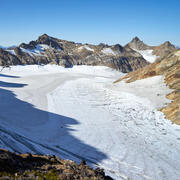I came to Alaska in 1999 to climb in the Alaska Range, and returned to work as an outdoor educator and mountain guide. At the time that was not part of a grand plan to intimately familiarize myself with glacier behavior, but I found myself increasingly interested in the physical processes of glacier change. Now I am the project lead for the Alaska portion of the Benchmark Glacier Project, a long-term project that quantifies seasonal mass changes on five glaciers in the US, three of which are in Alaska. My research focuses on accurately quantifying glacier change, understanding the physical processes that contribute to that change, and identifying feedback mechanisms that influence future changes. I work to understand how glaciers (and glacier change) influence surrounding ecosystems, both directly in terms of downstream runoff to rivers and oceans, and indirectly in terms of the overall ecosystem and landscape evolution. I am also interested in trying to make glacier science and glacier data more digestible and more approachable for land managers, decision makers, and the public.




























